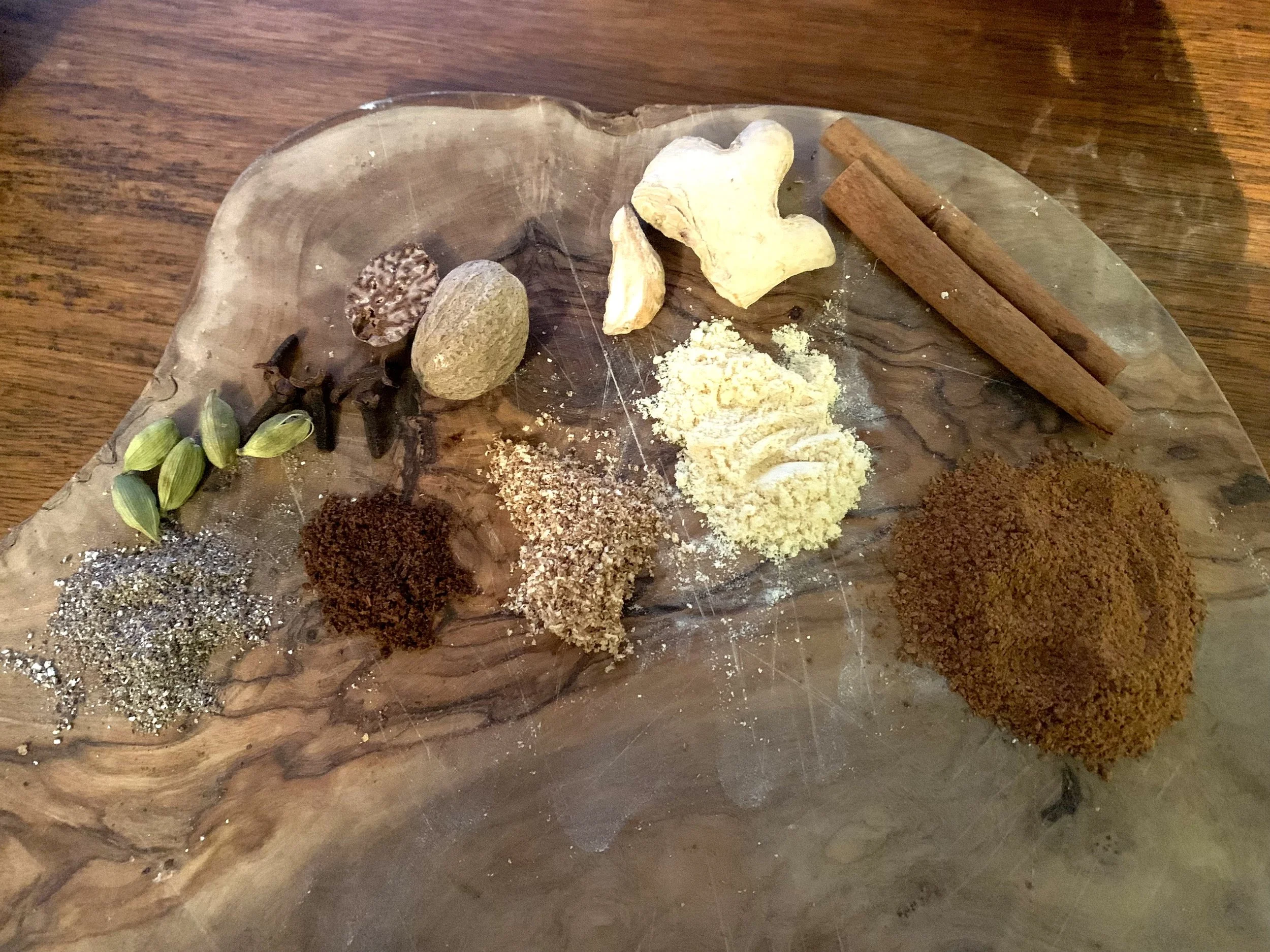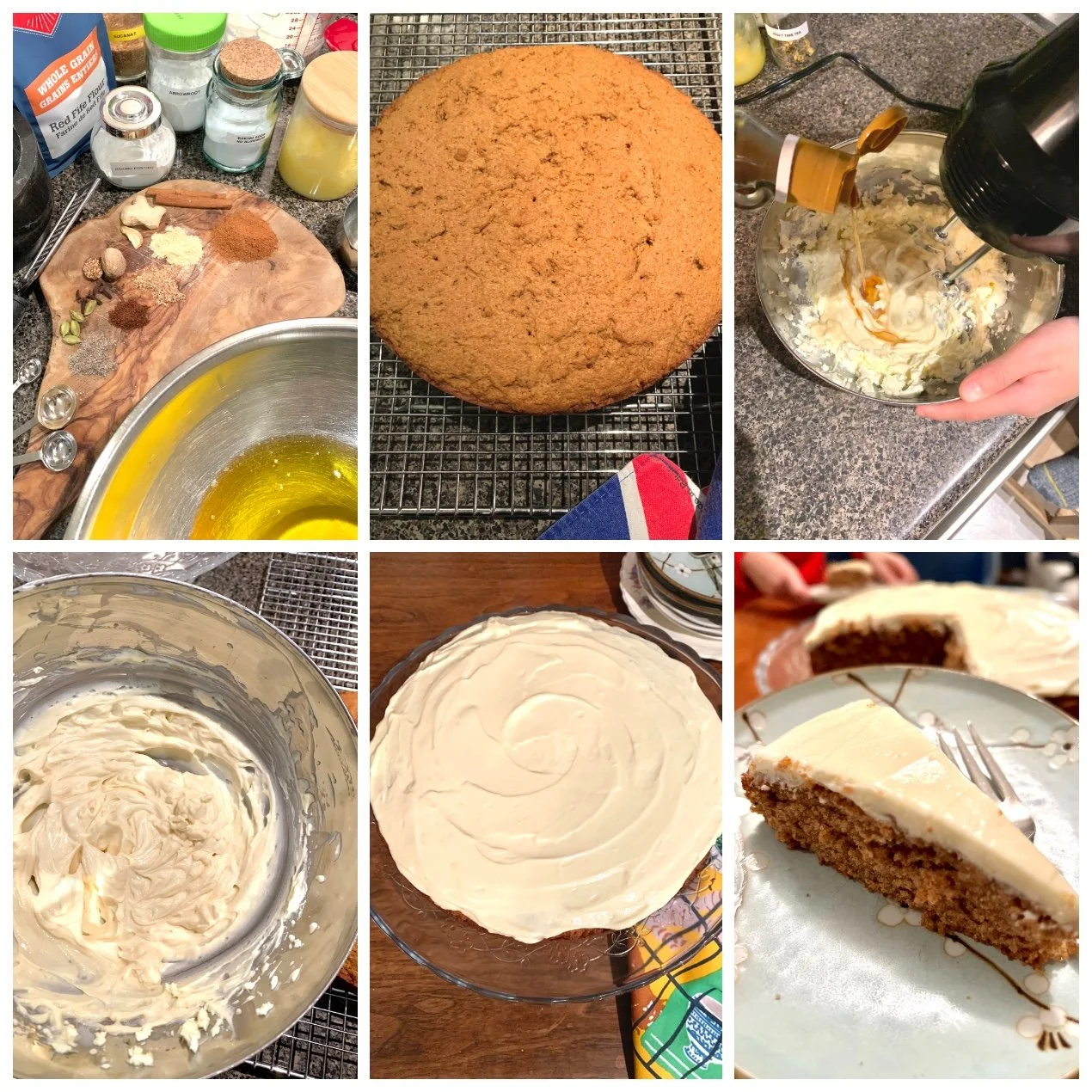Spice Cake with Maple Syrup Cream Cheese Icing
WELCOME TO MY BLOG! I’M EVANGELINE & A MOM. ALSO, AN RMT, and AYURVEDA-YOGA COUNSELLOR. I STARTED MY BLOG DURING COVID TO STAY CONNECTED TO MY CLIENTS AND SHARE MY LOVE OF COOKING HEALTHY, AYURVEDIC MEALS.
AYURVEDIC COOKING TAKES A BALANCED, HEALING APPROACH FOR YOUR DAILY COOKING NEEDS. YOU WILL FIND SIMPLE, EASY TO MAKE NOURISHING MEALS I HAVE MADE FOR MY FAMILY, WITH A DOSE OF AYURVEDA & YOGA WISDOM.
Updated October 6, 2024
Over the last few years I make a cake on my mom’s birthday. I miss her a lot. She was a kind hearted, beautiful lady inside and out, highly spirited and down right practical. Spice cake came to mind, as it reminded me of how she loved having ginger tea just about every night. So, mom this is for you. 💖 I can recall the aromatic, pungent scent of fresh ginger root as it steeped in a pot of boiling water on the stove. Making spice cake was a first for me, so reading some spice cake recipes guided me with the amount of spices to put in. The ratio of about 4 teaspoons of different spices, in a 2 cup batter, was what I generally came across. Cardamom was not a common spice I read in the recipes, but allspice was. You can play around with the individual spice ratios, depending on your preference. The recipe here is kid friendly as my son loved it and wanted another slice. He said he could “taste spices, but it’s not too much”.
As with all my recipes here, this spice cake recipe is infused with the knowledge of Ayurveda. Ayurveda is the ancient health system of India which means the “science of life”. Ayu means life and veda means science or knowledge. Ayurveda is at least five thousand years old and gaining a wider audience over the last few decades, likely following a similar trajectory to Yoga’s. In fact, Yoga and Ayurveda stem from the Vedas and together they are often referred to as “sister practices”. And in Ayurvedic cooking, spices are recognized for their ability to not only add flavour but for their medicinal properties.
In addition to spices and herbs, balance, freshness and digestibility are other key elements in Ayurvedic cooking, and baking. Balanced flavour (based on the six tastes in Ayurveda- sweet, sour, salty, pungent, bitter, astringent), using fresh ingredients (the least refined and processed the better), and adding spices to help digest the food and support the body’s innate intelligence.
The spices used in this Spice Cake recipe. From L to R: cardamom, cloves, nutmeg, sunthi (Ayurvedic dried ginger root), cinnamon.
Cardamom - green cardamom known in SVAyurveda for metabolizing protein- the pod’s skin binds the ama of protein molecules, and the seeds burn ama of the protein molecules; balances coordination between subdoshas of the stomach: samana vata, pachaka pitta and kledaka kapha
Cloves - opens the channels without aggravating pitta dosha
Nutmeg - calms the mind; has antiseptic properties; opens channels of the brain (yogavahi); energizes and balances the body; known in Ayurveda to support the nervous and endocrine system; has a sweet and musky aroma
Sunthi - Ayurvedic dried ginger root; ginger is a pungent, heating spice; helps break down fat molecules in the stomach; helps with arthritis (amavataghni) and constipation (vibandhanut); sunthi removes some of the heat and is less aggravating for high pitta conditions
Cinnamon - supports sugar and carbohydrate metabolism
As with all things, including spices, more is not necessarily better, even if it is good for you. Ayurveda pays close attention to the therapeutic value of spices and food with the understanding of their gross and subtle qualities. According to Ayurveda, food (ahara) is the first of three sub-pillars. Rest (nidra) and following the laws of nature (brahmacharya) are the other two. They function as a hierarchy. Food influences quality of sleep, and quality of sleep affects our mind and actions.
Ayurveda & Baking
My baking is simple, and with incorporating Ayurveda into it I use wholesome, fresh ingredients, organic when possible, and some substitutions to create healthy, balanced, yummy desserts:
instead of using vegetable oil, which are heavily refined, I use melted ghee. Read the benefits of ghee here. Olive oil or coconut oil is also an option. Coconut oil is heavy, and can be aggravating for several reasons—for example, if you have chronic digestive issues, you have a kledaka kapha imbalance, you have coconut regularly living north of the equator.
eggs and milk together are common ingredients in cakes and batters. Milk is a rich, heavy food with lot of soma energy. Since milk is not compatible with just about any food except grains and sugar, I sometimes use arrowroot or tapioca flour as the binding agent instead of eggs.
Arrowroot and tapioca flour can also be added when gluten-free flour is used, about 1-2 tsps per cup of gluten-free flour.
instead of refined sugar, I turn to unrefined or less refined cane sugar such as sucanat and muscovado. Honey is best not used in baking as it turns toxic when heated. When using maple syrup as your sweetener of choice you will need to add about 2 Tablespooons more flour.
instead of refined flour I use whole grain flour.
yeast causes bloating and gas and can lead to digestive issues; for example, when making pizza, I go with a flatbread like a simple chapati for the crust.
I use soma salt in my cooking and baking. Soma salt is a rock salt with a cooling property- not aggravating for pitta dosha, and is high in minerals. In Ayurveda’s ancient text Charak Samhita, Soma salt is considered the best salt of the eight types listed.
Spice Cake with Maple Syrup Cream Cheese Icing
Makes: 1 - 9 inch round cake
Prep Time: 15 minutes + 10 minutes if you grind your own spices
Bake Time: 30 minutes
INGREDIENTS for spice cake
1 tsp ground dry ginger or grated sunthi
2 tsp ground cinnamon
1 tsp ground cardamom
½ tsp ground nutmeg
¼ tsp ground cloves
¾ cup ghee or coconut oil, melted
2 ¼ cups red fife or einkorn flour
2 tsps arrowroot flour
¾ cup sucanat cane sugar
2 tsps baking powder
¾ tsp baking soda
¼ tsp soma salt or sea salt
1 ⅓ cup buttermilk or 50-50 plain yogurt and water combined
INGREDIENTS FOR ICING
½ cup cream cheese
¼ cup butter, softened
½ tsp ground cardamom (optional)
1 Tablespoon maple syrup
directions
Preheat oven to 350F.
Line a 9-inch round spring form pan with parchment paper and grease with some of the ghee. Set aside.
Melt the ghee in a small saucepan. Add the spices and whisk all together. Set aside.
Combine the flour, arrowroot, sugar, baking powder, baking soda and salt in a large bowl.
Add the spiced ghee and buttermilk in the flour mixture and mix all together by hand with a wooden spoon, or a mixer on medium speed. The batter will be a bit thick.
Transfer the batter into the pan, spreading evenly with a spatula.
Bake for 30 minutes, or when a toothpick comes out clean when poked through the centre.
Let cool on a wire rack for about 20 minutes if you plan to cover with icing, or serve after 10 minutes with a dollop of icing.
To make icing, combine the cream cheese and butter with a mixer until smooth, then add maple syrup and mix for another minute.
If serving the next day, cover the cake and store in a cool place or in the fridge. The next day, let the cake come to room temperature, about 30 minutes, before serving.
Enjoy!
Reference
Vaidya R. K. Mishra- Notes from Shaka Vansiya Ayurveda Courses, Practicum, Conferences and Lectures, 2003-2015
David Frawley, Vasant Lad, The Yoga of Herbs, 2001



